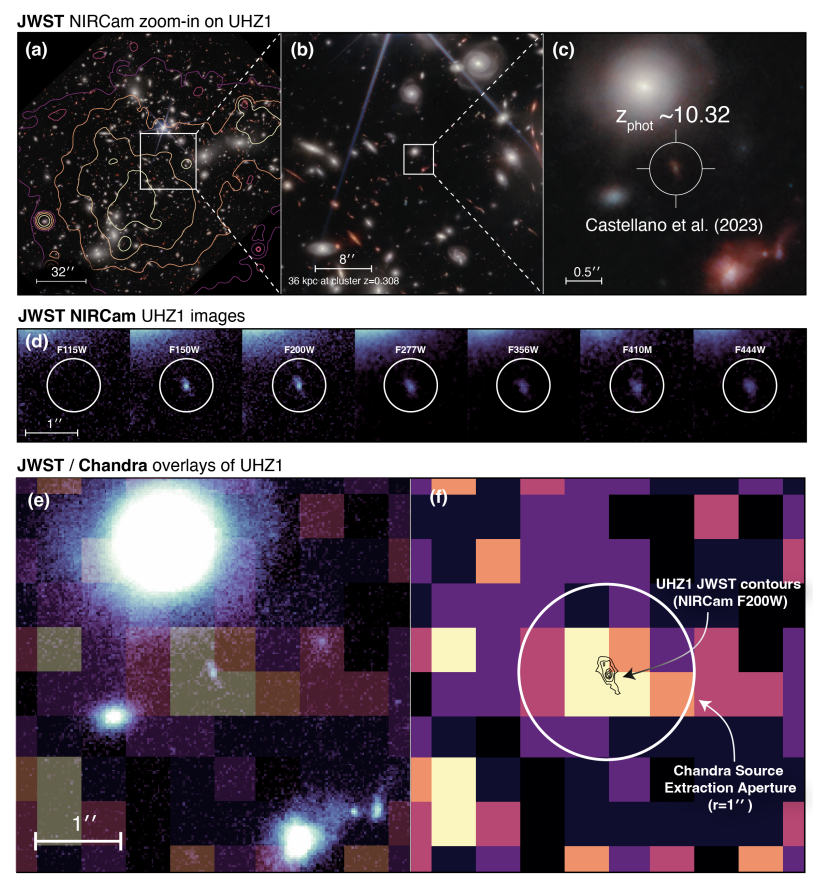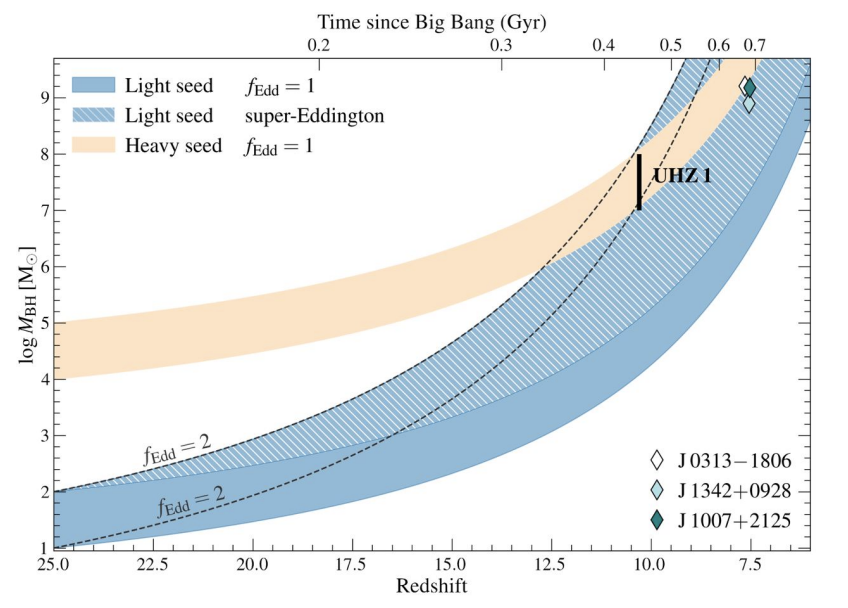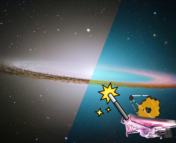Title: First Detection of an Over-Massive Black Hole Galaxy: UHZ1 – Evidence for Heavy Black Hole Seeds From Direct Collapse?
Authors: Priyamvada Natarajan, Fabio Pacucci, Angelo Ricarte, Akos Bogdán, Andy D. Goulding, and Nico Cappelluti
First Author’s Institution: Department of Astronomy, Yale University, New Haven, CT 06511, USA
Status: Submitted to ApJ Letters [open access]
JWST has, in the past year alone, already surpassed many expectations in its capacity for uncovering new and fascinating details about the early universe. One particularly perplexing trend emerging from JWST data in recent months has been the observation of numerous black holes in the very early universe that are more massive than previously expected. Recently, a dual JWST & Chandra X-ray Observatory measurement of a galaxy known as UHZ1 confirmed the presence of a huge black hole just a few hundred million years after the big bang, further confounding the issue. In today’s paper, the authors explore how this recent observation in particular may support a longstanding theory that some of the initial “seeds” of supermassive black hole (SMBH) formation are actually heavy black holes formed via the direct gravitational collapse of massive gas clouds in the early universe.
Supermassive Seedlings

It’s a common refrain among astrophysicists at this point—you’ve probably heard it before, something like: “Hiding in the center of nearly every galaxy in the universe lies a supermassive black hole, millions or billions of times more massive than our sun…” But what may surprise you is that despite our confidence in the omnipresence of these gargantuan objects, our knowledge of how they formed in the first place is extremely limited. In order to grow to such incredible masses, we know SMBHs need to form over cosmological timescales, being continually fed by surrounding gas and stars and occasionally merging with other massive black holes. This gradual growth across the last several billion years is just one part of this story, however; just like all of the tallest trees, these monstrous black holes had to start from humble origins as “seeds”. For SMBHs, these seeds must have been some sort of population of smaller black holes with just the right properties to initiate the continual growth SMBHs later undergo at the centers of galaxies.
While there is very much we still don’t know about these SMBH seeds, we do know that they formed in a very different cosmic environment than the one we live in today, and they must have somehow set the stage for the super-charged growth of SMBHs over the next several billion years. This means that in order to fully piece together the evolution of SMBHs, we need to understand black hole formation and growth mechanisms across billions of years and through many different epochs and cosmic environments, not all of which are well studied due in part to the difficulty of resolving objects at high redshift (meaning further back in time). Our lack of understanding of cosmic environments in the first few hundred million years after the big bang in particular limits our ability to discern between competing theories for SMBH seeding. While the “feeding” of SMBHs in our local universe can be indirectly observed through the intense radiation emitted by active galactic nuclei (AGN) which surround some central black holes, these environments have until recently been much harder to find and study at high redshifts.
Luckily for us, a new space telescope specifically tuned to observe the universe at high redshift started taking data last year. You may have heard of it—it’s called JWST! Among the many intriguing discoveries about the early universe enabled by JWST so far has been the recent discovery of multiple quasars (a specific type of galaxy containing a very bright AGN) at redshift exceeding z=9, indicating the presence of massive accreting black holes only a few hundred million years after the big bang. In today’s paper, the authors argue that observations of one of these quasars in particular provides one of the first pieces of direct evidence from which we can infer the existence of a particular class of theorized SMBH seeds known as direct collapse black holes (DCBHs), shedding light on this previously hazy era of black hole formation.
DCBHs, OBGs & UHZ1

The seeds from which SMBHs are thought to sprout are typically categorized in very broad terms: are the seeds light, or heavy? Light seeds are typically conceived of as black holes with masses ranging from 10-100 solar masses which would most likely form as the result of stellar collapse in the very first generation of stars only about 100 million years after the big bang. The idea that SMBHs are seeded from this early population of black holes gains some immediate credence due to the fact that we already understand the necessary formation mechanism (the gravitational collapse of massive stars), but it is still somewhat unclear to researchers how these light seeds could grow to the sizes necessary to eventually become SMBHs. On the other hand, “heavy” seeds are black holes which manage to grow to 10,000-100,000 solar masses at similarly early times through various proposed mechanisms. One such heavy seed formation mechanism involves the direct collapse of massive gas clouds in the early universe. The thinking goes a bit like this: in the early universe, massive gas clouds orbiting around the earliest star-forming galaxies are prevented from cooling efficiently due to radiation from the aforementioned neighboring star formation. As a result of their inability to cool and form stars of their own, these gas clouds eventually become gravitationally unstable, causing gas to rush towards the center, eventually forming a central black hole. These direct collapse black holes (DCBHs) then merge with the larger star-forming galaxy and continue to grow in tandem with it. The large initial mass of DCBHs and the subsequent co-evolution with their host galaxy leads to the formation of a system where the mass of the central black hole rapidly becomes comparable to the mass of the surrounding stars. This resulting ratio of central black hole mass to stellar mass is in stark contrast to galaxies today which typically have central SMBHs with masses equal to only 0.1% of their host galaxy’s stellar mass. As a result, these theorized objects are often referred to as Outsize Black Hole Galaxies (OBGs). Given that other types of black hole seeds are not expected to produce OBGs, a detection of one of these objects in the early universe would provide evidence for the existence of DCBHs and thus the existence of heavy black hole seeds as a viable candidate for explaining at least some portion of SMBH formation.

So have we found any OBGs? According to the authors of today’s paper, it’s looking more and more likely that we have. The trail of evidence begins with the initial detection of a set of bright galaxies in JWST imagery all around a redshift of z=9-10 in the field of the massive galaxy cluster Abell 2744. Then, in order to examine the properties of these galaxies’ central black holes, a team lead by Akos Bogdán at the Center for Astrophysics Harvard & Smithsonian employed a different space telescope called the Chandra X-Ray Observatory to look for X-ray emission commonly associated with rapidly accreting black holes. The team found significant evidence for X-ray emission associated with one of the galaxies dubbed UHZ1 and found that the emission they observed fit well with existing models for AGN X-ray spectra. By understanding the underlying physics that dictates how much material a black hole of a given mass can accrete, and therefore how much X-ray emission its accretion disk can give off, the team was even able to estimate the mass of the black hole, putting it at a whopping 107-108 solar masses. Given a similar estimate for the galaxy’s stellar mass derived from JWST data, Dr. Bogdán and his team suggest that UHZ1 may indeed fit the bill for an OBG. However, this stellar mass estimate relied on fitting the galaxy’s observed brightness in different filters against template spectral energy distributions (SEDs) for standard galaxies which don’t account for the influence of an overly-massive central AGN. Thus, to confirm if UHZ1 really fit the bill for an OBG, researchers needed to employ a new set of SEDs tailored to these objects’ unique properties.

In today’s paper, the authors generate these SEDs in order to more accurately model the properties and formation history of UHZ1. Because of the variety of parameters involved in generating OBGs, from the metallicity of the gas and stars to the accretion history of the central black hole, a variety of templates were generated to find which produced a reasonable match to the data. While one template formed from a simulation of the extremely rapid growth of light seeds came close to matching the shape of the observed spectral distribution, it predicted a dimmer overall magnitude for the resulting OBG and X-ray emission too low to have been detected, contradicting the strong X-ray detection reported by Dr. Bogdán and his team. Ultimately, the best-fitting spectral template was instead generated from a simulation which evolved an initial seed with a mass of about 10,000 solar masses at a more physically reasonable rate over the course of a few hundred million years. This simulation reproduced the observed color of UHZ1, its ratio of X-ray to Infrared emission, its general spectral distribution, and overall brightness. Given the relatively poor fit of other initial seed masses and accretion models, the authors claim that a light seed origin for this system is strongly disfavored by the data—making a heavy initial seed in line with the expected properties of a DCBH an increasingly plausible explanation for UHZ1’s properties.
What’s Next for Heavy Seeds and OBGs
While there is still a huge amount of research left to be done to understand the emerging population of high mass black holes in the early universe and their connection to SMBHs today, the close fit of UHZ1 with existing heavy seed models is an intriguing first step that suggests we may soon be able to answer some longstanding questions about the origin of some of the most massive objects in our universe. The authors caution, however, that these observations don’t yet allow us to make definitive claims about whether these early universe black holes are fit to grow into the SMBHs of today’s universe. Simulations have suggested, for example, that sometimes the soil is more important than the seed: some of the most massive black holes at high redshifts may not be able to grow consistently enough to continue to be the most massive black holes at lower redshifts due to other environmental factors. Understanding these other factors outside of the seed mass alone that affect black hole evolution will thus be necessary to fully piece together the puzzle that is SMBH formation.
Astrobite edited by Cole Meldorf
Featured image credit: Bogdán et al. 2023.




